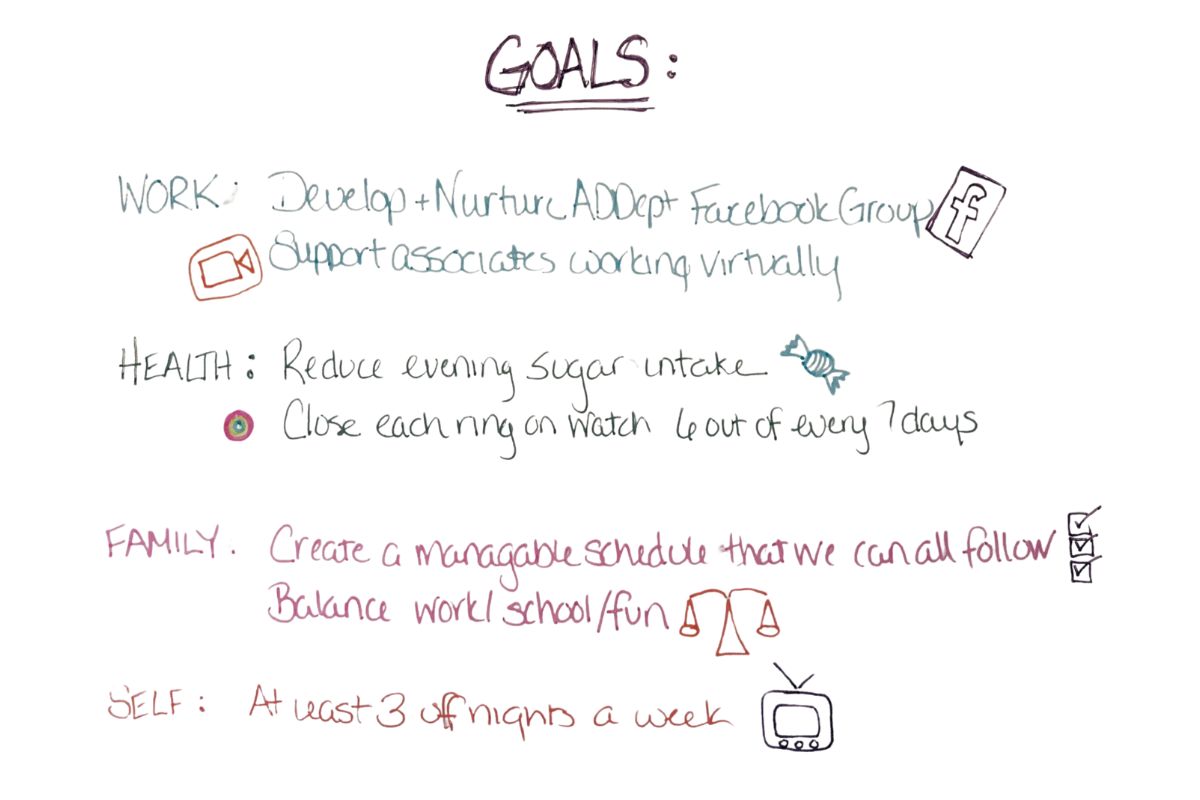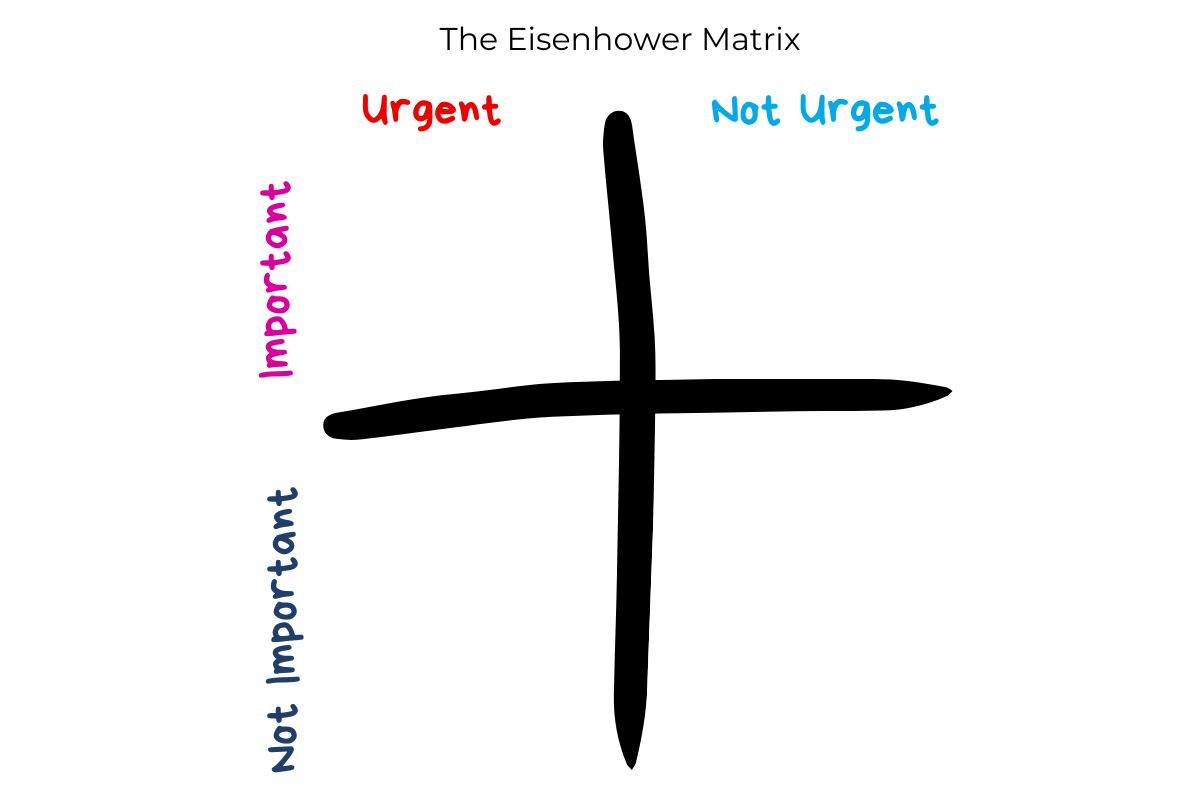A 5-Step System to Boost Productivity
Let’s face it. Time is finite. There will always be more to do than is time to do it. It will not all get done. I repeat: It will not all get done.
This means we need to figure out the most important thing to do and ignore the rest.
That’s a whole lot easier said than done, though- right?!? It’s rife with executive functioning cost:
Problem-solving
Decision making
Ordering
Each one of these tasks drains that precious supply of executive functioning energy. And so people often skip all the prioritizing and just get right into action.
I get that- the draw of the action is strong and powerful. But the problem is that the draw of action leaves you in responding mode- putting out whatever fires crop up and then crumbling into a heap of exhaustion- (the red/blue slide). This isn’t only tiring, but it doesn’t get you or your life moving in the direction that YOU want.
So, how do you do the hard thing of prioritizing when all your brain wants to do is respond? You front-load the hard work:
Sit down and map out your priorities when your executive functioning energies are high (usually late morning, though your personal time clock may differ).
But don’t just try to muddle through all on your own. This 5-step process will bring you clarity and help you move toward the things that really matter rather than just what feels shiniest at the moment.
Front-loading prioritization tasks when your executive functioning is at its peak helps reduce ADHD overwhelm and eliminates the decision-making fatigue that often leads to burnout. By planning ahead, you’ll minimize those reactive moments that drain energy and leave you stuck in ADHD freezing or shutdown mode.
Step 1: The Brain Dump
Before you do anything- put it all on paper (or a google doc- whatever works best for you). Every single thing:
- the front of mind things
- the things that have been circling for weeks that you keep not doing
- the things that you “should” do
- the things that you “ought to do,”
- the things you desperately don’t want to do
- the things that you can’t wait to get started
I want it all, in no particular order (unless it helps spur your thought process).
You’ll forget things- that’s ok- a good task list (which is what this will evolve into) is a living breathing thing- you can’t ever kill it- you just keep adding and subtracting. So don’t shoot for perfection here- just get the things down that you can think of.
The brain dump is your ADHD prioritization starting point, and it’s a powerful way to clear the mental clutter. Think of it as a reset for your executive function—removing the endless mental ping-pong of tasks from your head and putting them into a manageable format. By offloading all those swirling thoughts, you create space to focus on the tasks that align with your time management goals.
This process also reduces ADHD overwhelm by giving your brain permission to stop holding onto every little reminder. Use tools like voice-to-text apps if writing feels tedious, and remember to revisit your brain dump regularly—it’s an evolving map of your productivity journey.
Step 2: The Goals
Now, I want you to put that brain dump aside and make a list of your goals—try to keep these to 1 or 2 per life area (i.e., work, health, family, self). These are medium-range things that you might be reaching towards. For example, when I did this recently, my goals looked like:

These are goals—they are aspirational. I may not reach them (last week’s empty box of Oreos and frequent notices from my watch telling me to get up and move are a testament to the fact that we don’t always get there). But they’re also not so ridiculous that I couldn’t fathom meeting them.
Your goals should act as a compass, pointing you in the direction you truly want to go. For ADHD prioritization to work, they need to be clear yet realistic—ambitious enough to inspire you but grounded enough to avoid overwhelm.
By keeping goals manageable, you reduce executive function overload while still moving toward your larger aspirations. Review your goals regularly to make sure they align with your current priorities and don’t hesitate to revise them as your needs and circumstances change.
Step 3: List Due Dates
Now I want you to return to your brain dump, and, beside each task, I want you to put when/if it has a due date.
For some tasks, this will be easy—the project that is due on Friday, and the taxes that are due to your accountant on March 25.
For other tasks, there may not be a specific date, but a general time it would be good to have completed it. If that’s the case, then what is the time range where it should be completed? Then work backward: For example—maybe you need to schedule your yearly physical. You had one last fall, so you want to prepare it for September and you know it takes about 3 months to get an appointment, so you need to call for an appointment by June.
Some really have no deadline—that is fine, just leave it blank.
Adding due dates isn’t just about deadlines—it’s about creating a roadmap for your ADHD task organization. By assigning realistic timelines, you reduce ADHD overwhelm and bring structure to what might otherwise feel chaotic.
For tasks without hard deadlines, consider setting soft due dates to keep momentum. Tools like calendars, reminder apps, or task management platforms can help ensure these timeframes stay visible, nudging you toward completion without added stress.
Step 4: Draw Your Matrix
Now you have your goals, your deadlines, and your tasks. Now it’s a matter of organizing them and figuring out what is most important. For this, I like to use the Eisenhower Matrix, which maps tasks on the 2 scales of importance and urgency: creating 4 quadrants:

The Eisenhower Matrix is a game-changer for ADHD time management because it transforms an overwhelming to-do list into a clear action plan. The four quadrants—urgent and important, urgent but not important, not urgent but important, and not urgent and not important—help you prioritize tasks with ADHD productivity in mind.
Don’t hesitate to use color coding or visual cues when drawing your matrix. ADHD brains thrive on visual organization, and adding colors for each quadrant (like red for urgent tasks) can make it easier to focus on what truly matters.
Urgent and Important
These are the tasks on fire—the deadlines coming up right away for the tasks that really matter. These tasks will both get you to your goals and need to be done soon. These tasks are often RED tasks on the solve-it grid.
Urgent and important tasks demand immediate attention and often carry high stakes, making them impossible to ignore. Examples might include submitting a work project on a tight deadline, attending a critical medical appointment, or handling an unexpected family emergency.
For ADHD brains, tackling RED tasks first can create a sense of accomplishment, but don’t let them dominate your time. Block off specific hours in your schedule to ensure you address these pressing matters without sacrificing long-term priorities.
Urgent but Not Important
This is a funny category because these things seem really important because they have urgency attached, but they are not actually aligned with your personal goals. Oftentimes, these are things that others are asking of you or they are commitments you made without taking stock of your goals and intentions.
Urgent but unimportant tasks can easily hijack your day, pulling you away from what truly matters. These are often requests from coworkers, favors for friends, or minor tasks like answering non-critical emails or attending optional meetings.
For ADHD brains, it’s crucial to identify these tasks and set boundaries to avoid overcommitting. Delegate them when possible or schedule them for a less demanding time, ensuring your energy remains focused on your personal priorities.
Not Urgent and Important
These are often long-range goal tasks- (many times these are the YELLOW in the solve-it grid). They are vital to moving your life in the direction you desire, but if you don’t do them today, it’ll be ok. These are things like rewriting the company mission statement, making a doctor’s appointment, or reworking the backend procedures of your company.
Focusing on these tasks improves ADHD productivity by aligning your efforts with meaningful, long-term goals that truly matter.
Not Urgent and Not Important
This box is full of things that do not have a timeline and do not align with your goals. When you think about it—why are you carrying these things around at all if they are not important and not urgent, anyways? These are the ones you want to take a hard look at and see if you really need to do them—they are often things to outsource or just make peace with not doing.
Using the Eisenhower Matrix for ADHD task organization helps you identify and eliminate these unnecessary tasks, freeing up mental energy for what truly matters.
Step 5: Matrix Your List
Now, with a list of your goals clearly stated beside the matrix, go one-by-one on your brain dump. Use the deadline noted to identify if it is urgent or not, then look at your goals and see if it moves you towards one of your goals. If yes, then it’s important. If not, then it goes in the not-important column. Keep moving one at a time until you have ordered the entire list.
This step helps streamline ADHD task organization by ensuring your time and energy are spent on what truly aligns with your priorities.
Ok, I Have It Matrixed—Now What?
The inclination here is to just get started on the Urgent and Important category, but I’m going to suggest just the opposite. The Urgent/Important category is really RED—it’s shiny, flashy, and has a lot of draw. You’ll get there all on your own, I promise. But if you just address that with no plan for the others, you’ll continue to have this feeling that you are not doing things you really should. Instead, try approaching your matrix with these 3 steps:
Taking the time to tackle less obvious but equally impactful tasks will ensure your ADHD productivity remains aligned with long-term goals.
Step 1: Off-load Your Unimportants
Start with the unimportant column. But set a timer before you go there—5 minutes tops, these things are not important so don’t waste your precious time here—go through quickly and see: What can you cross off completely, what can you make peace with not doing? What can you give someone else to do?
By trimming down unnecessary tasks, you free up mental bandwidth to focus on priorities that matter most.
Step 2: Hack Your Grid and Schedule the Important/Not Urgent
Now, move over to your important column. In Solve It grid language: the Urgent/Important are all RED tasks—they are things that are on fire, and you have a huge amount of drive to get done because if you don’t, something terrible will happen.
The Important/Not Urgent square is YELLOW—they are the hardest but often the most important to get done. So they need to be done at a time, and in a way, that assures their success. In order to do this, you need energy—energy to get over the hurdles that’ll show up when you start to try to tackle them. If you start your day with a GREEN activity (something that gives you fuel, that energizes you, and ignites you) then you are going to be so much more likely to be able to tackle these Important/Not Urgent tasks right after. For more examples and clarity on this, check out the solve-it grid article.
By scheduling YELLOW tasks when your energy is high, you set yourself up to make consistent progress toward long-term ADHD prioritization goals.
Step 3: Attend to the Urgent/Important as They Arise (Except for That One Special YELLOW Time)
The Urgent and Important tasks get done. It doesn’t always look pretty, and sometimes it’s a little over the deadline, but they happen. There’s natural motivation to get them done. You don’t need to schedule a time to do them usually, but you do need to schedule a time NOT to do them. This keeps some time in your day free from the constraints of responding. So scheduling a time in the morning, right after green, to tackle some YELLOW, without the interruption of RED, assures those precious YELLOWS get done while reserving the rest of your day for RED.
Creating boundaries around RED tasks ensures that the YELLOW priorities don’t get overlooked, making ADHD time management feel more intentional.
Remember, this is a skill, and it’s not a skill that the ADHD brain does without effort. So this will take some time and hard work at first. But you can do hard things. And the more you do it, the easier and more natural it will feel.
And when it starts to feel more natural and easy—that’s when you really feel like you have a grasp on your time, your tasks, and, ultimately, your life.
Ready to take control of your time and priorities? Connect with one of our ADHD specialists to build strategies tailored to your journey.



